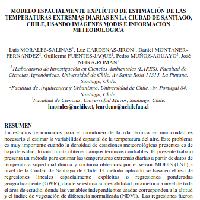Resumen
- En estudios relacionados para el monitoreo de la isla térmica en una ciudad es necesario el estimar la variabilidad espacial de la temperatura del aire. Este problema es muy importante cuando la densidad de estaciones meteorológicas presentes es de baja densidad, lo cual limita obtener campos térmicos confiables. El presente trabajo presenta un método para estimar las temperaturas extremas diarias a partir de datos de temperatura superficial diurna y nocturna obtenidos por el sensor MODIS (LST) a nivel de la Ciudad de Santiago de Chile. El método aplicado se basa en el uso de regresiones lineales espacialmente explícitas o regresiones ponderadas geográficamente (GWR), donde se estima la inestabilidad paramétrica a nivel de toda el área de estudio, donde las variables independientes usadas corresponden a la altitud y el índice de vegetación de diferencia normalizada (NDVI). Las regresiones fueron todas significativas, sin embargo, los mejores resultados del ajuste y evaluación de los modelos lineales para temperaturas máximas y mínimas se obtienen con datos de LST-MODIS día y noche en forma conjunta (mixtos) que por separado. Los resultados muestran que las regresiones espacialmente explícitas GWR presentan una buena precisión para la estimación de las temperaturas extremas diarias a partir de la temperatura superficial de noche y de día MODIS en comparación con OLS.
- In related studies for monitoring the thermal island in a city it is necessary to estimate the spatial variability of air temperature. This problem is very important when the density of meteorological stations present a low density, which limits to obtain reliable thermal fields. The present work shows a method to estimate the daily extreme temperatures from daytime and night surface temperature data obtained by the MODIS sensor (LST) at the level of the City of Santiago de Chile. The applied method is based on the use of spatially explicit linear regressions or geographically weighted regressions (GWR), where parametric instability is estimated at the level of the entire study area, where the independent variables used correspond to the altitude and the vegetation index of normalized difference (NDVI). The regressions were all significant, however, the best results of the adjustment and evaluation of the linear models for maximum and minimum air temperatures are obtained with day and night LST-MODIS data jointly than separately. The results show that the spatially explicit GWR regressions present good accuracy for the estimation of daily extreme temperatures from the MODIS day and night surface temperature compared to OLS.
